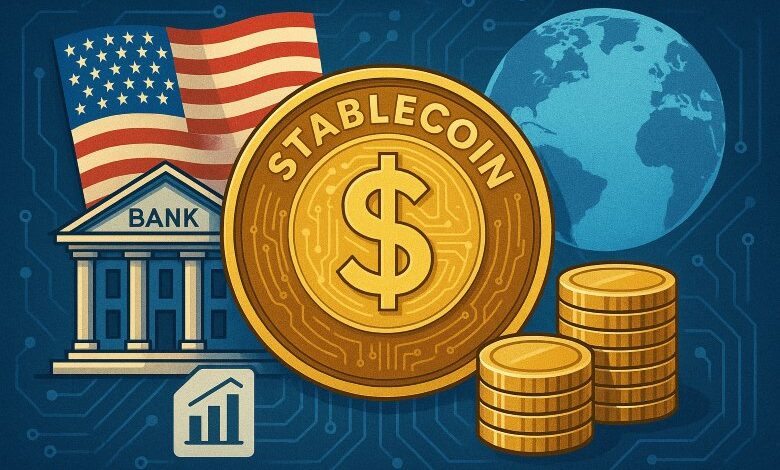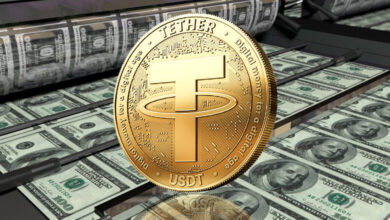Stablecoins Emerge as the Financial Engine of the Digital Asset Era

As the digital asset world matures, one thing is becoming increasingly clear: stablecoins are no longer a crypto side story—they are fast becoming the oil that lubricates the financial infrastructure of the future.
Over the past month, a series of major developments in the United States has crystallized a new reality: stablecoins are not just here to stay—they are now at the center of global financial evolution.
U.S. Banks Enter the Arena
In a move that would have been unthinkable just a few years ago, the largest U.S. banks—including JPMorgan Chase, Bank of America, Citigroup, and Wells Fargo—are exploring the launch of a joint stablecoin. According to the Wall Street Journal, the effort is being discussed through co-owned payment entities like Zelle (Early Warning Services) and The Clearing House.
The aim? To take back control of transaction rails before stablecoins issued by crypto-native firms, tech giants, or even foreign actors erode the dominance of the traditional banking system. Unlike earlier experiments, this time the momentum is driven by institutional alignment, policy tailwinds, and a sense of strategic urgency.
The GENIUS Act: A Legal Framework for Stablecoins
This shift comes as the U.S. Senate advances the GENIUS Act of 2025, a bill designed to regulate both bank and nonbank stablecoin issuers. It introduces mandatory reserve standards, redemption protocols, anti-money laundering requirements, and public reporting—all tailored specifically for payment stablecoins.
Significantly, the bill positions stablecoins as neither securities nor commodities, helping to resolve longstanding regulatory ambiguity. It also sets the stage for foreign issuers to operate in the U.S., provided they register, hold reserves in U.S. institutions, and comply with American oversight.
It’s a foundational framework—one that signals to Wall Street, Silicon Valley, and global regulators that stablecoins are now part of the financial core, not the fringe.
Where Is USDC?
And yet, one name is conspicuously absent in this new institutional narrative: Circle, issuer of USDC. Long held as the most regulatory-friendly stablecoin, USDC appears to be sitting out the banking consortium, at least for now.
Some speculate this silence is due to Circle’s pending IPO, which requires careful navigation of regulatory optics. Others believe the company may be weighing a strategic acquisition, or has chosen to pivot toward B2B infrastructure services rather than mass consumer issuance.
Whatever the reason, Circle’s current posture reflects a broader recalibration: in the race to mainstream stablecoin finance, banks may no longer need crypto-native pioneers to lead.
USDT: Offshore, Unbothered, Unmatched
While U.S. banks strategize and Circle pauses, Tether (USDT) continues to dominate globally. It remains the most-used stablecoin in Asia, Latin America, the Middle East, and DeFi ecosystems. But its future in regulated Western markets looks increasingly limited.
Under the GENIUS Act, Tether would likely be ineligible for U.S. registration without radical transparency and structural reforms—something the company has shown little intention of pursuing. Instead, USDT has settled into a different role: offshore liquidity layer, immune to U.S. constraints but increasingly vital to global users with dollar needs and limited banking access.
🇦🇪 UAE: A Vision Still in the Making
The UAE has been among the first globally to regulate stablecoins, with the Central Bank issuing a framework for payment tokens and granting the first license to AEcoin. On paper, this puts the UAE ahead of most jurisdictions.
But in practice, the market is still in its early stages.
- AEcoin is operationally limited while it works with the Central Bank to expand its use case.
- Other applications are pending, with no public roadmap on their approval.
- Circle’s USDC has received in-principle approval in ADGM, but it’s not yet live—and not authorized for domestic payment use.
- Tether’s ambitions in the UAE have reportedly stalled, with regulatory friction hindering expansion.
- Lift Dollar (USDL) by Paxos, licensed under ADGM, has launched with a yield-bearing model—but adoption remains modest and limited to a few B2B and remittance pilots.
The UAE’s role is still promising, but increasingly in question. With the right infrastructure, talent, and regulatory clarity already in place, the opportunity is real—but time is ticking. As banks and policymakers around the world act more decisively, the UAE risks being remembered as the first to move—but not the first to scale.
Public and Private Chains Converge
Another key development comes from R3, the enterprise blockchain company behind Corda, which announced a strategic partnership with the Solana Foundation. This alliance aims to connect private banking networks with public blockchain infrastructure, using stablecoins as a universal transaction layer.
(Corda is also the underlying technology for many central bank digital currency (CBDC) infrastructure pilots across the region, including the UAE’s CBDC initiative.)
It’s a sign of what’s coming: a world where regulated finance and decentralized finance are no longer rivals, but layers of the same system—with stablecoins at the center.
The Battle to Define the Future of Value
Stablecoins are no longer just digital dollars. They are programmable liquidity. Financial APIs. The value layer of the Internet.
From Washington to Abu Dhabi, the race is on to define who issues, controls, and scales the new digital instruments of money. In the U.S., policymakers and megabanks are aligning behind a shared stablecoin future. In offshore markets, USDT continues to dominate decentralized liquidity. And in the UAE, a strong regulatory foundation exists—but activation remains cautious and incomplete.
What’s at stake is not just who adopts stablecoins, but who sets the standards, owns the rails, and captures the trust of users across borders. This isn’t just about payment speed or blockchain choice. It’s a geopolitical, financial, and technological battle to define the future of value—and it’s accelerating.





